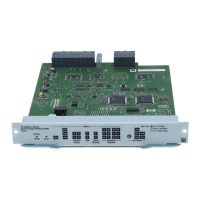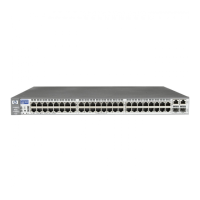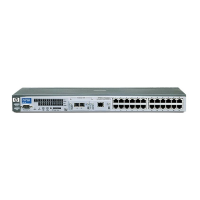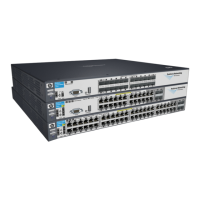11-24
Port Trunking
Trunk Group Operation Using LACP
Figure 11-11. Blocked Ports with LACP
■ If there are ports that you do not want on the default VLAN, ensure that
they cannot become dynamic LACP trunk members. Otherwise a traffic
loop can unexpectedly occur. For example:
Figure 11-12. A Dynamic LACP Trunk Forming in a VLAN Can Cause a Traffic Loop
Easy control methods include either disabling LACP on the selected ports or
configuring them to operate in static LACP trunks.
ProCurve(eth-B1-B8)# show lacp
LACP
PORT LACP TRUNK PORT LACP LACP
NUMB ENABLED GROUP STATUS PARTNER STATUS
---- ------- ------- ------- ------- -------
B1 Active Dyn1 Up Yes Success
B2 Active Dyn1 Up Yes Success
B3 Active Dyn1 Up Yes Success
B4 Active Dyn1 Up Yes Success
B5 Active Dyn1 Blocked Yes Failure
B6 Active Dyn1 Blocked Yes Failure
B7 Active B7 Down No Success
B8 Active B8 Down No Success
VLAN-1
(Default
VLAN)
VLAN-2
VLAN-1
(Default
VLAN)
VLAN-2
VLAN-1
(Default
VLAN)
VLAN-2
VLAN-1
(Default
VLAN)
VLAN-2
If the ports in VLAN 2 are configured to allow a dynamic trunk (and GVRP is disabled), adding a
second link in VLAN 2 automatically forms a dynamic LACP trunk and moves the trunk to VLAN-1
(the default VLAN), which creates a traffic loop in VLAN 1 between the two switches and
eliminates the link in VLAN 2 between the two switches.

